It's Finally Safe To Join Twitter
“Muting a user on Twitter means their Tweets and Retweets will no longer be visible in your home timeline, and you will no longer receive push or SMS notifications from that user. The muted user will still be able to fave, reply to, and retweet your Tweets; you just won’t see any of that activity in your timeline.” — Unfollowing, blocking, now muting: Twitter accommodates the full spectrum of human avoidance.
I Just Ate Fruit for the First Time and It Kind of Sucked
by Matthew J.X. Malady
People drop things on the Internet and run all the time. So we have to ask. In this edition, writer and editor Joe Veix tells us more about what it was like to have lived 26 years without eating any fruit.
I’m 26 and have never eaten fruit, AMA!
— Joe Veix (@joeveix) April 24, 2014
Joe! So what happened here?
It’s true, I’ve never eaten fruit. I’ve had avocados and tomatoes, but I’ve been told those “don’t count.” I’ve also never had juice, though I do drink red wine. That’s technically juice, right?
To be clear, I’m not just being picky. I’m an open-minded guy and like to try everything once. I just get nauseated about even thinking of eating fruit. I’m not sure why. I used to get sick a lot when I was younger, so my theory is that I probably attempted to eat fruit while ill and my brain associated those two things — like how if you get food poisoning after eating salmon rolls, for two and a half decades of your life you won’t be able to stomach seafood or sail a boat or look at the ocean.
But it hasn’t been too difficult for me. I think part of the reason I’ve gotten so far into my life without having to actually confront this is that it’s been easy to avoid fruit. Our country is very unhealthy, and most fruit comes in candy form. (I should mention, I’ve never had candy fruit.)
It’s only ever been socially awkward. For example, if someone brings something with fruit in it to a dinner party and they offer it to me, and I refuse to try it, they get really offended. I then have to explain this whole weird thing to people I just met, and then they think I’m fucking with them, and then usually everyone at the party will just start listing different fruits. “What about apples?” “No.” “Oranges?” “No.” “Jujubes?” “No!”
I’ve frequently been offered money in exchange for trying fruit — on one occasion as much as $500. But my dignity is not for sale!
There was also one time a few years ago when I was working as a production assistant for a TV show, and I had to pick up groceries for the office. I didn’t know what a lot of fruits on my list actually looked like — I have no fruit buying experience — and the supermarket didn’t have any identifying signs.
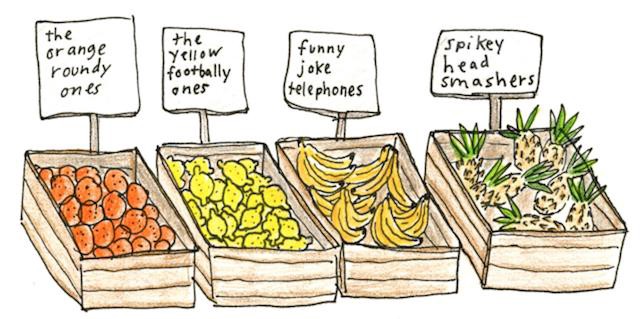
I was too embarrassed to ask anyone for help, so I used my phone to Google image search all of the fruits. I creeped out a few nice elderly ladies who saw me very sternly holding my phone in front of each basket of fruit, one by one. After I couldn’t confirm the difference between lemons and limes, I had to send a photo to my then-girlfriend to get confirmation. It was a close call.
Also, if I go to a birthday party and the cake turns out to have fruit in it, that’s terrible. Because I love cake.
I realize it’s mostly psychosomatic, but the nausea is so bad that I sometimes get grossed out just by the scent of fruit. If someone starts peeling an orange on the subway I’ll have to switch cars, or risk vomiting.
Despite this, it was my New Year’s resolution to try fruit.
Whoa. But as much as it would be interesting to keep the whole “no fruit thing” going forever and perhaps achieve some sort of record, it’s probably not the worst thing in the world that you’ve gotten to a point where you may be ready for some changes. Could you do me a favor and try some grapes, a few mango chunks, a slice of apple, a kiwi, and a peach right now for the first time and let me know what you think?
Sure! I enlisted my friend Jenny as my “fruit ambassador,” because I don’t know how to pick out fruit or how to go about slicing and peeling it. I might accidentally eat a core or a sticker. In the grocery store, Notorious B.I.G.’s “Juicy” started playing while we felt peaches, which I took to be a good omen.
In addition to fruit, I got a bar of dark, spicy chocolate as a palate cleanser and a 22-ounce beer to ease my nerves.
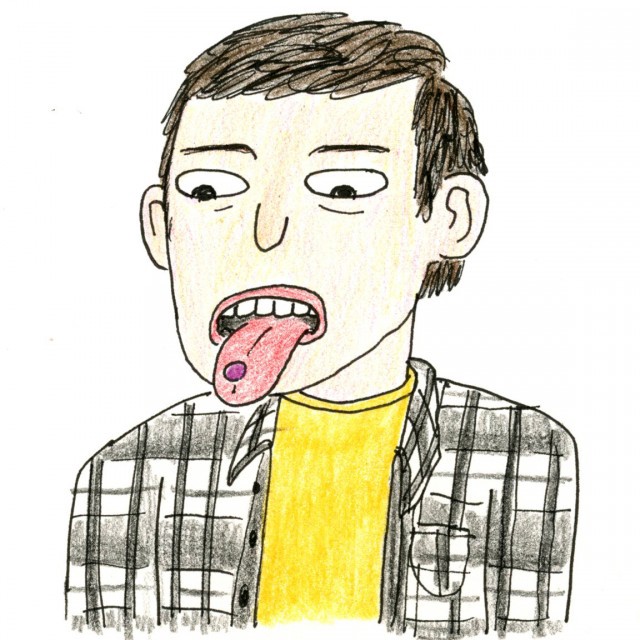
1. Grapes (seedless, red)
I started with one that was pea-sized. It had a plastic texture, like the smooth side of a Lego. I chewed and swallowed it without a problem, so I tried a bigger one. When I bit down it exploded in my mouth, which surprised me so much that I yelled “ew.” Eating it felt like chewing on grass that was wrapped around chilled mucus.
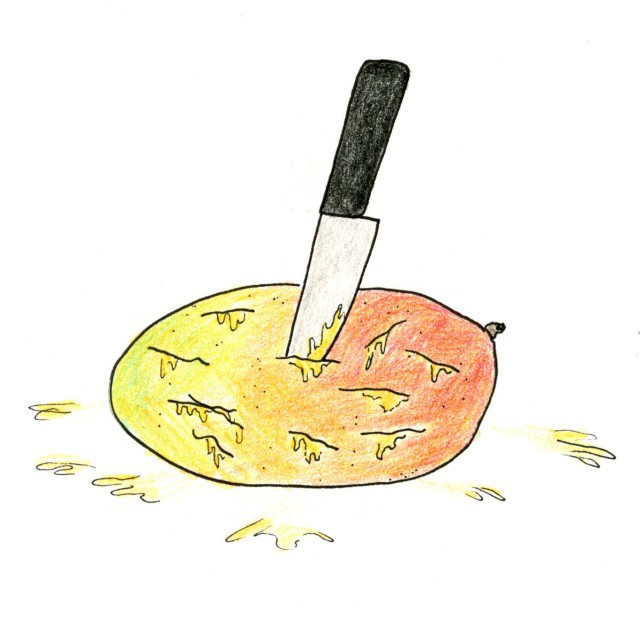
2. Champagne Mango
My friend showed me her elaborate grid cutting system for mangos, while explaining that her mother used to say that “mangos are the apples of the Philippines.” The analogy was lost on me. I excitedly took a bite, and violently gagged. I somehow managed to choke it down. It tasted like stomach acid. I don’t remember anything else about it. It’s possible I blacked out. The whole thing was basically a core, too, like how a potato chip bag is mostly air. What a huge rip-off. Fuck mangos, man.

3. Apple (Fuji)
I ate a slice, and it didn’t taste like much — like damp cardboard. Bland and crunchy. The juice kind of grossed me out, but I didn’t mind the taste and texture overall. I could see myself enjoying it on a salad, or maybe in a pie. Feeling empowered, I bit straight into that sucker, which felt oddly satisfying.

4. Kiwi
This is my friend’s “top five favorite fruit.” Based on how it looked, and still reeling from my mango failure, I was very nervous. The piece that she cut for me had the look and texture of green sashimi, with seeds that looked like specks of dirt. But I actually enjoyed my first bite. I ate two more pieces, and really liked them too. I kept smiling about it, and my friend pointed out that I had seeds in my teeth, but I didn’t even care, I was so happy about kiwis.
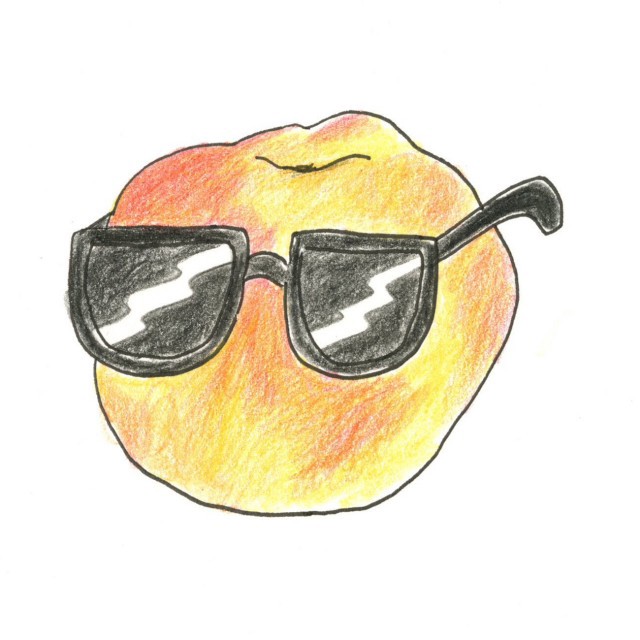
5. Peach
I was skeptical about peaches (re: mango PTSD). The slice tasted similar to the apple, though the skin was pleasantly bitter. Like the kiwi, I was able to eat it without any issues. I asked my friend to demonstrate how she would “casually” eat a peach, like a normal person on the bus, and then I copied her — chewing like I imagined James Dean would — and we talked about politics.
Lesson Learned, if any?
Fruit is actually pretty good! (Except for mangos.) I know it’s a cliche, but you really have to overcome your fears and try new things, even if those things make you vomit, because life is short, and probably even shorter if you don’t eat fruit.
Just one more thing.
I’m very excited and optimistic about my new lifestyle. I’ve opened up an entire chamber of the food pyramid! I can now drink all sorts of fancy cocktails and smoothies! I could get a new wardrobe! The whole world is brimming with delicious, juicy possibilities.
Matthew J.X. Malady is a writer and editor in New York. Illustrations by Hallie Bateman.
Sharon Van Etten, "Drive All Night"
Last week, a silvery Bruce Springsteen flashed a peace sign at photographers from a vintage Corvette. One day earlier, he was “photobombed” by Steven Spielberg at the USC Shoah Foundation Gala, where he shared a table with Barack Obama. The same week, the first draft of his lyrics to “Born to Run” were put on display at Duke University as objects of historical interest; they had recently been sold to a collector for $160,000. Meanwhile, back in Asbury Park, Sharon Van Etten is good at singing.
Fraternities Treated Charitably
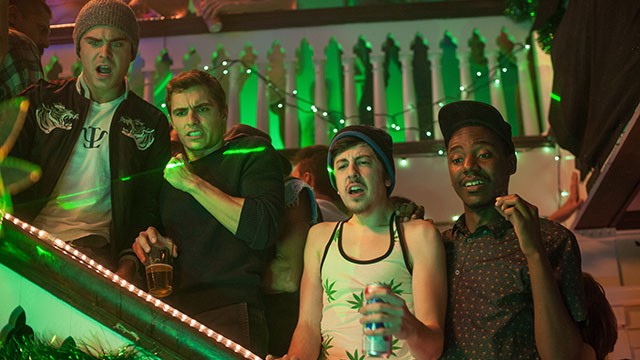
Neighbors made $51 million this weekend, which is about as much as Spider-Man 27, The Other Woman and Heaven Is For Real combined. It’s an easy movie in the way the best Apatow spin-offs and descendants are: There are no real villains, all adults are basically children, and everyone is eventually rehabilitated.
It’s also incredibly careful in its representation of fraternities, which are painted as silly but never sinister. A former fraternity brother might watch this movie and feel empowered or proud. Certainly he wouldn’t feel embarrassed. He might feel handsome! At the very least he would feel relieved, after years of defending his own experience in the context of widespread and intensifying revelations of hazing, sexual assault and general campus deleteriousness. In the movie, both hazing and rape are dispensed with in short, knowing sequences; the men of this movie are buffoons, but they’re more or less enlightened. Little about their personas or their parties is dark — the guys are never shown in the context of their university, possibly because doing so coherently would be impossible. They’re just wacky, college-adjacent stoners with great physiques and flexible schedules.
Anyway, thank god for the Daily News, who found a “real life” version of Neighbors unfolding in Queens, where fraternity brothers are hosting all-night parties and scrawling obscene graffiti without the help of professional screenwriters:
The latest mess — written in permanent black ink — will be left for all to see long after the co-eds leave for the summer, they said.
“There are a lot of kids here,” said resident Allan Punsalan, who lives two houses down from the frat. “They play on the block. “That’s pretty bad….”
A 22-year-old SJU senior who declined to give his last name insisted the messages were “just in joke.”
“My retarded friend did it,” said the student, Douglas, who promised to clean up and keep it down. “I didn’t think we were doing anything to disturb them, honestly. We just watch sports here. We had one small party.”
Yeeesss, yessssss, that’s more like it. This is what frats are really best at: Preserving teenage nastiness through the four years that are supposed to extinguish it.
Winter Is Over
Winter Is Over
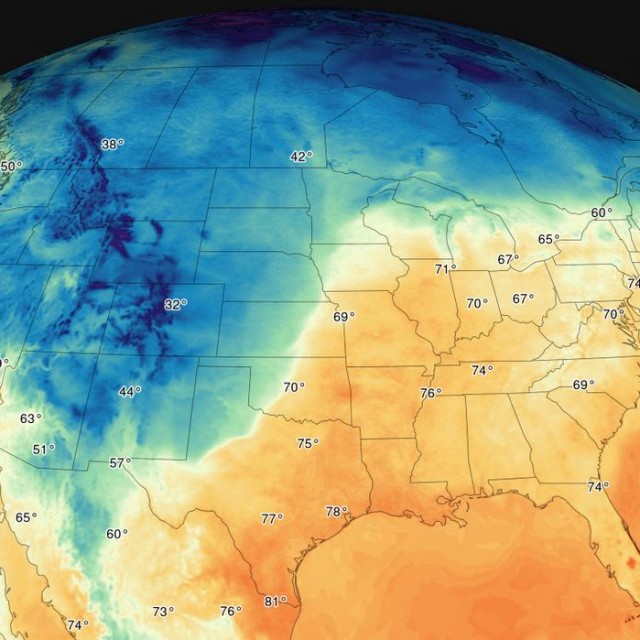
Yesterday, the temperature in New York City reached eighty-one degrees Fahrenheit; it will not dip below fifty degrees again this week. We are pleased to announce that winter, which began sometime in November, has finally come to a close after six long months.
Spring will be vanishingly brief. It occurred during the first paragraph of this post. The sticky season is already upon us, and it will be thick and unforgiving and last an age. The grim ecological consequences of global warming aside, this is worth celebrating: New York City is at its best when everyone is slightly miserable, hardly dressed, glistening and surrounded by a light cloud of funk. At the very least, it is never more equitable: everybody suffers. And there is no greater bond than shared, unbridled misery with precious little relief in sight.
Lieutenant Governor Liked, But Is He Well-Liked?
“Most political observers gave the sober Duffy good marks for his lieutenant governorshipdom, but he still only has 1,500 followers on Twitter compared to Gov. Cuomo’s 116,000.”
I Write These Stupid Words: Weezer's Normcore Revolution
by Craig Jenkins
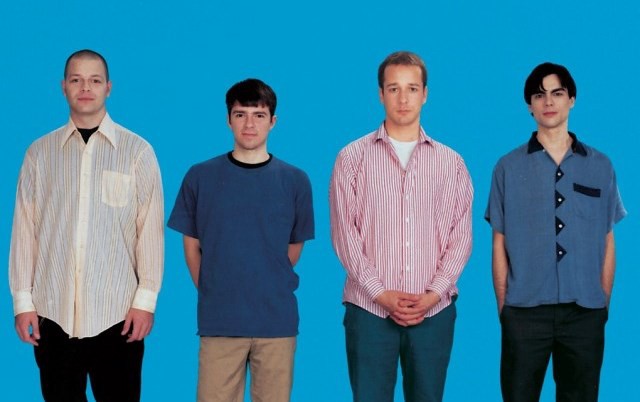
In the wake of Nirvana, major labels handed out deals to anybody with a moody disposition and a guitar. Everyone from the lesser known friends of successful bands (the Melvins, the Meat Puppets) to weird rock institutions (Ween, the Butthole Surfers, the Flaming Lips) suddenly became objects of major label lust.
It was around that time that Connecticut-raised singer-guitarist Rivers Cuomo, who had moved to Los Angeles in search of stardom, pieced together a ragtag band of transplants to bring his songs to life. The band, called Weezer, landed at DGC Records, the same Geffen subsidiary that Kurt Cobain and Courtney Love’s bands called home. With the help of legendary Cars producer Ric Ocasek, tapped after Cuomo was talked out of producing himself, the band selected ten of the sharpest songs that it had road tested over the last year and laid down a self-titled debut. Weezer , affectionately referred to by fans as The Blue Album for its plaintive blue cover, surfaced on May 10th, 1994, filled with pithy power pop nuggets that infused nineties alt-rock attitude with a dash of seventies glam panache and early rock formalism.
By the end of its first week, it had moved only 90 copies. “You can open Billboard magazine, and our name isn’t even in there,” Rivers told Denver’s Westword weeks after release. Geffen graciously greenlit a video for The Blue Album’s lead single, “Undone (The Sweater Song).” Disinterested in pigeonholing themselves into one-hit wonderdom with a video that cheesily dramatized the song’s anthemic refrain, “If you want to destroy my sweater,” the band chose the only treatment that didn’t: crack videographer Spike Jonze’s suggestion of “a blue stage, a steadicam, and a pack of wild dogs.” The clip for “Undone” took off at MTV, and Jonze and Weezer’s follow-up vid for “Buddy Holly,” a pitch-perfect spoof of the seventies sitcom Happy Days interwoven with actual show footage, shot the group from buzz bin curiosity to national ubiquity. By year’s end, Weezer’s stone-cold flop had turned platinum.
The Blue Album turned nineties slacker ennui in on itself, deftly leveraging humor and subversive emotional depth rather than beelining straight for bleeding heart sentimentality. Its singles required a little unwrapping; you could settle for shouting the Blue singles’ catchy choruses back at the radio until it dawned on you what they were really about, or you dispensed with the surface absurdity to grapple with the pathos underneath. “Say It Ain’t So” seemed to laze about in disaffected meandering until the middle eight arrives, scratching at Rivers’ fear that his stepfather’s drinking would lure him away from the family the way his biological father’s did. “Undone” centered around around the goofy bit about pulling a frayed sweater apart, but it’s actually an account of a breakdown, which resonated both with listeners who related to its frailty and the larger pool of kids who mistook it for an empty-headed singalong. (Cuomo: “It was a very sad song about depression, and people heard it on the radio and thought it was hysterical.”)
While the album’s singles hooked by stashing profundity inside wry humor, the deep cuts could be outright heartsick. “No One Else” stacks up untenable dream-girl characteristics (“I want a girl who laughs for no one else”); “The World Has Turned and Left Me Here” emotes when those unrealistic expectations extinguish a real romance; and “In the Garage” and “Only in Dreams” both reminisce about a lonesome adolescence. The former seeks solace in ’70s geek ephemera — X-Men action figures, Dungeons & Dragons paraphernalia — while the latter forsakes the waking world for a sleeping one, where an unrequited crush actually reciprocates. Blue wore the pains of winsome boyhood pridefully; it was as if Cuomo, mop-topped and bespectacled, had maneuvered out of the weird years of his youth and left a breadcrumb trail behind for the rest of us.
Weezer’s ascent could be attributed as much to songwriting as to sound architecture. Ric Ocasek fashioned the twin tendrils of Rivers’ guitar and Matt Sharp’s fuzzed out bass into a wall of sound too hooky to be menacing, but a few degrees too tart to be mistaken for genteel. The Blue Album’s default setting was a methodical, unfussy riffing that made great company for the three- and four-chord wonders populating rock radio in 1994. It was deadly effective, chugging alongside drummer Pat Wilson’s economic playing on mid-tempo tracks like “Holiday” and “In the Garage,” but the band lost no intensity slowing to a crawl for the album’s compelling closer “Only in Dreams,” or punching up for the punky “Surf Wax America.”
Rivers’ writing could be restless, too, and many of Blue’s finest moments double as its most compositionally adventurous. “Undone” is a slow-burning build from the quietude of the verses through the cracked mania of its coda that crashes into a din of strummed piano strings in its closing moments. “Surf Wax America” thrashes through two choruses before collapsing unexpectedly into a bridge of barbershop vocals and racing home; “Holiday” plots a similar course. “Only in Dreams” spends four minutes establishing a plodding rhythm before bringing both song and album to a stunning conclusion on a blissed out crescendo that smashes everything to bits.
In typical self-effacing fashion, Rivers would downplay his talents and Weezer’s unlikely providence in an aborted 1995 Rolling Stone interview that was catalogued in his 2011 memoir, The Pinkerton Diaries. “My primary objective is to write stupid ass pop music,” he quipped. “If you want to dig a little deeper, there’s usually something there, but there’s certainly no obligation to do so.” But the net effect of The Blue Album’s success was injecting the scene’s unflinching austerity with a much needed measure of levity. It was a fitting alternative for the serious boys’ club of the era, the Corgans, Vedders, Duritzes and Kowalczyks who dominated early nineties rock radio with blistering dispatches from a psychiatrist’s couch.
Cuomo’s peers were merchants of a deeply earnest, disaffected cool. They sang about pressing issues; they took up noble causes. They posited their rock stardom as a commentary on the stupidity of rock stardom. But Weezer shook things up even more, lionizing normalcy. The Blue Album sought inspiration in the mundane, winking pride in looking like a square, and meaning in Kiss records. It reveled in all the big, dumb feelings boys are raised to bottle up. The undateable dream girl isn’t just on his mind, she’s in the chemical makeup of the air; the ex-girlfriend didn’t leave, the whole world did. Blue’s pursuit of tension-releasing loud-quiet dynamics won it an audience in its own time, but Cuomo’s defiant lack of cool and threadbare directness allowed it to outlive much of the rest of what 1994 had to offer. Two decades later, the emo kids still build their kingdoms of broken hearted melodrama around Rivers’ blueprint.
Like its baby faced mastermind, The Blue Album shows few signs of age twenty years on. Its truths are all our truths, and allegiances pledged in awkward youth endure.
Craig Jenkins a New York-based troublemaker who’s written for Pitchfork, Spin and Complex.
New York City, May 8, 2014

★★ The rainy morning was as congenial as it could be — dimness but not darkness, a steady but not soaking rain. Circles spread across the puddles; droplets beaded on the bright green leaves. A low-hanging branch swept back the two-year-old’s hood as he took his shoulder-ride, and he didn’t mind. The battered everyday sneakers got a little damp and no damper; cotton flannel felt close and excessive, the way wool had felt a few weeks before. The late day, after the rain, was as unexpectedly grim and raw as the earlier, wetter part had been unexpectedly bearable.
How Long Before All Of New York City Is Declared A Superfund Site?
How Long Before All Of New York City Is Declared A Superfund Site?

The most radioactive place in the entire city has just been declared an EPA Superfund site, joining two other recently honored features: The Gowanus Canal and Newtown Creek. The first of NYC’s toxic trio was designated worthy of federal intervention in early 2010. That’s three new sites since early 2010. NYC is on a roll! But where will this roll take us? Data can provide answers.
Two of these Superfund sites are large waterways; one is basically a city block. This, along with the fact that 2+1=3, means that our data is useless. Anyway: Based on rough Google Maps measurements these sites average out to approximately 70.6 acres apiece. At a rate of one new Superfund site every 1.4 years, and assuming a total five-borough acreage of 205,000, New York will be Superfund City by the year 6079. July, roughly.
How Is Martha Stewart Doing?
by Brendan O’Connor

“I live on a farm. I cook. I garden. I craft. I do all those things,” Martha Stewart said, as a giant, high-resolution lobster glowed behind her. “I’m your mom.”
Martha — it’s always “Martha” — had just returned to New York after a trip to China, where the Wall Street Journal reports she is plotting a “cupcake revolution.” She also met with the team behind e-commerce giant Alibaba, which she found to be very inspiring. “China is the land of opportunity. If you are an entrepreneur, or interested in the growth of a new middle class, China is the place to go,” she said. “I do hope the censorship is lifted.” Her enthusiasm for Alibaba notwithstanding, the wider Internet garners only imperious disdain from Martha. And why shouldn’t it? Websites like Pinterest and Instagram harvest the content of publications like hers all the time: “If we’re the most-pinned magazine, we should get paid for that,” Martha said. There is more bridal content available to consumers than ever, she lamented, even as fewer and fewer young people are getting married. “Shame on you!” Martha admonished the overwhelmingly female crowd of mostly journalism students. “It’s fun! It’s a rite of passage.” She laughed, and so did everybody else in the room.
As far as her own media consumption goes, Martha listens to NPR and reads the Wall Street Journal, the New York Times, and “a tabloid, the name of which I will not mention” on her commute from Katonah, New York, where she lives. She reads these cover to cover, and is disappointed in young people for reading newspapers on their phones. “You miss a lot,” she said. (She’s not wrong!)
Martha was speaking to former editor and publisher of the Nation, Victor Navasky, for Columbia Journalism School’s weekly Delacorte Lecture on Magazine Journalism, held in the school’s Joseph Pulitzer World Room. The appearance is part of an effort in recent months to rehabilitate her image — and in turn, her company, since the two are inextricably linked, and things have not gone well of late: Martha Stewart Living Omnimedia shares “have slid from a high of $37.40 to less than $3 for much of last year,” Bloomberg reported in January. “Along the way, the company has shed more than $1 billion in value.” (Martha did well by the estimation of at least one audience member: “She looks good,” admired the woman next to me.)
Martha referred to the incarceration that precipitated her company’s slide as “an unpleasant interlude.” While in prison, “I learned a lot about what is wrong with this country,” Martha said. “There are a lot of people who don’t belong there. We should be ashamed of what we do to people.” At some point, she will begin work on her autobiography, in which she plans to address her experiences with the American justice system and offer ideas about prison reform, but for now she’s busy working to save her floundering company.
Indeed, Martha is busier than ever — which is maybe why she earned $21.2 million between 2009 and 2011, even as MSLO lost money — and she likes it that way. “I don’t relax. I like ‘doing,’” she answered in response to a question about how she finds time for herself. “There’s no rest.” Even holidays are work. “We’re already thinking about my Halloween costume for this year,” she said. “I celebrate every holiday at least twice, maybe three times a year. I eat a lot of turkeys.”
Martha dodged one audience question from a young woman about how to use gender to one’s advantage, but tackled another about how women should manage work-life balance and stress. “I am very good at knowing who is pregnant and who is not,” Martha said, referring to the women who work for her. “They don’t want to tell me, but I always know who is going to come back and who is not.” Navasky chuckled along, looking like an old leftist Santa Claus. Martha said she failed at balancing her own life, however, since her own 29-year-long marriage ended in divorce. “I don’t miss him,” she added. Her daughter is divorced as well, although Martha had only praise for the sperm donor who fathered her grandchildren and has become involved in their lives. “I just keep telling myself, ‘It’s the modern family,’” Martha said. “You just have to adapt.”
Brendan O’Connor is a reporter living in New York City.
Photo via
